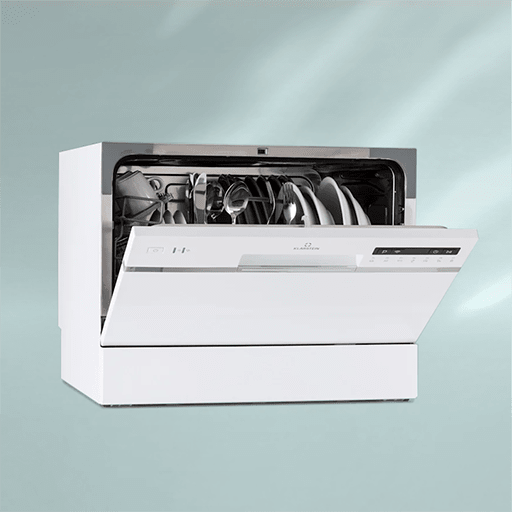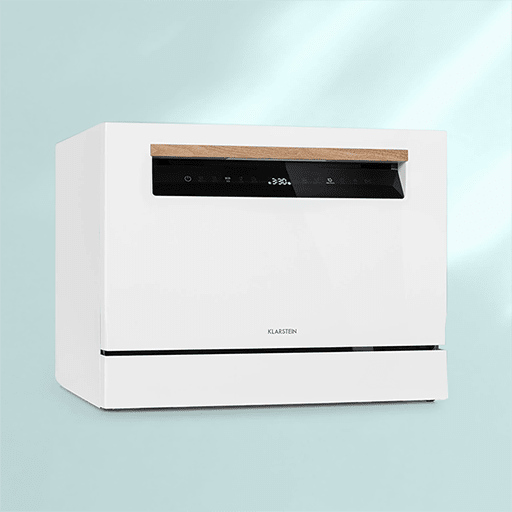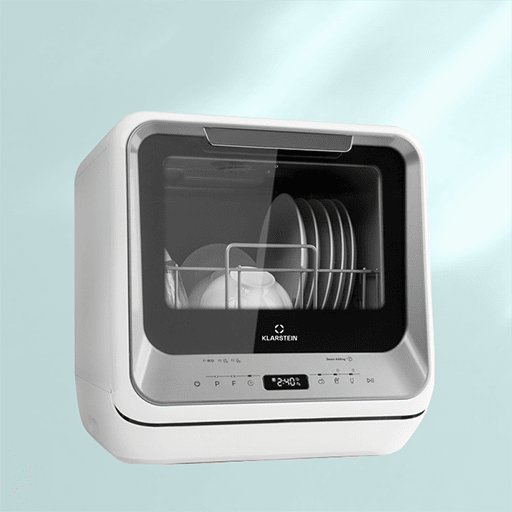Dishwashers - Test and Guide
The dishwasher is probably one of the greatest kitchen aids of our time. Luckily, with a dishwasher, annoying washing up and polishing is a thing of the past. Do you need a new dishwasher? Then you're in exactly the right place with us. In our large guide, we'll show you the different models and give tips on how to choose the best dishwasher.
Features and performance of dishwashers
When buying a dishwasher, you should pay attention to various features. First, energy efficiency is important, as dishwashers can account for a significant portion of household energy use. A machine with a higher energy efficiency class saves energy and costs in the long term. Second, the size of the dishwasher is crucial to ensure that it fits into your existing kitchen counter or sink area. Finally, the volume is an important factor, especially in open kitchens or if you have sensitive ears. You can also pay attention to various factors when it comes to the design and inner workings of your dishwasher: is it a built-in device, free-standing or a particularly small dishwasher? A cutlery drawer or a basket? It's your choice!
Klarstein Dishwashers

Product Tip
Amazonia 6 Smart Dishwasher
7 programs, intuitive operation and a simple, elegant design: This dishwasher really fits in anywhere.
- As a built-in or free-standing device
- With a quick program
- Easy installation


Klarstein dishwashers adapt to your life and your kitchen - design, size, programs: You can choose whatever suits you best. With intuitive operation and easy installation, they can be quickly installed in your home and provide you with loyal service in the fight against dirty dishes.
- Very easy installation
- Can be placed flexibly
- Various colours and designs
Advantages:
Klarstein Built-in Dishwashers

Product Tip
Havasia UV 8 Dishwasher
Hygienic cleaning thanks to 6 programs and UV light to eliminate microbes. The built-in dishwasher delivers clean and dry dishes.
- UV light to eliminate microbes
- Available as a built-in or free-standing device
- Easy operation with LED display


The built-in dishwasher is the most common in our kitchens. Simply integrated into the kitchen unit, it completes the look of your cooking oasis and is always ready to clean dishes and cutlery in no time at all. The Klarstein built-in dishwashers are easy to install in a kitchenette, making them an indispensable part of your home.
- Elegant integration into the kitchen
- Simple operation on the front of the dishwasher
Advantages:
- With the built-in variant, the dishwasher must be taken into account when planning the kitchen.
Disadvantages:
Klarstein Tabletop Dishwasher

Product Tip
Lagoona Dishwasher
The tabletop dishwasher is particularly water saving, looks elegant and can be placed anywhere on tables, worktops and sideboards.
- Elegant front with wooden trim
- Consumes little water
- Ideal for small households


Tabletop dishwashers are the ideal solution where there is already a kitchen in which no dishwasher has been installed. You can easily find space for the dishwasher anywhere, it can be easily connected to the water supply and it cleans your dishes effortlessly with little water consumption. The ideal solution for everyone who lives in rented apartments, small households and flat shares.
- Can be set up flexibly
- Low water consumption
- Quiet in operation
Advantages:
- Cannot be used as a built-in device
Disadvantages:
Klarstein Mini Dishwashers

Product Tip
Amazonia Mini Dishwasher
The little helper in everyday life: Mini dishwasher with two spray arms for small households or the mobile home!
- Low consumption of 5 L
- No water connection required
- Mobile, flexible use


The little heroes in single kitchens, holiday flats or in the mobile home! Mini dishwashers with a width of 45 cm take up little space, do not require a water connection and clean your dishes in no time at all. They only use a small amount of water, which is filled in using a water tank. This means that the small dishwasher can be used wherever there is a power connection.
- Space saving
- Practical for single households
- Without installation
Advantages:
- Small capacity of 2 place settings
- Not suitable as a built-in device
Disadvantages:
Dishwasher Comparison
| Klarstein Dishwashers | Built-in Dishwashers | Tabletop Dishwashers | Mini Dishwashers | |
|---|---|---|---|---|
| Price / Performance | Very good, 399.99 Euro | Good, 439.99 Euro | Good, 409.99 Euro | Good, 329.99 Euro |
| Product dimensions | 49.5 x 55 x 43.5 cm | 60 x 55 x 50 cm | 44 x 44 x 51.5 cm | 44 x 42 x 44 cm |
| Weight | 21 kg | 28 kg | 20.5 kg | 14 kg |
| Water Consumption | 6.5 litres | 8 litres | 6.5 litres | 5 litres |
| "Number of place settings | 6 | 8 | 6 | 2 |
| Functions | 7 programs with a 45-minute quick program, with app control | 6 programs, UV light, automatic door after program end | 7 + 1 programs, 360° wash | 6 programs, 360° wash" |
| Features | Intuitive control panel | Water connection, LED display | Luxurious front, touch control panel | Water tank, LED display |
| Special features | Smart device suitable for built-in installation | Suitable for built-in installation, quiet operation | Tabletop dishwasher, not built-in | Mobile, especially small |
| Colour options | Black, white | Black | White | Black, blue, silver |
Tips for buying a dishwasher
Before you order your new dishwasher, ask yourself what exactly you need, what you value and what fits into your home. To make your decision as easy as possible, we've put together 5 questions that will help you make the most of your new dishwasher:
- How much space do you have in your kitchen for a dishwasher?
- To save electricity and water, which energy efficiency class should the dishwasher have?
- To determine the right capacity of the dishwasher, how big is your household and how often do you use dishes?
- Which programs and functions are important for your needs? (e.g. intensive program, short program, start time delay)
- What is your budget for buying a dishwasher?
Dishwasher FAQs
A semi-integrated dishwasher is a device that is specially designed for a fitted kitchen. In contrast to a fully integrated dishwasher, which is completely hidden behind the kitchen front, a semi-integrated dishwasher has a visible control panel at the front. This control panel is usually integrated into the design of the kitchen to ensure a consistent look. However, the rest of the dishwasher, including the door and interior, is not visible and is hidden by the kitchen front. In this way, the semi-integrated dishwasher blends harmoniously into the overall look of the kitchen.
A fully integrated dishwasher is a device that disappears completely behind the kitchen front, so that it is visually seamlessly integrated into your kitchen. The controls are invisible and the entire front of the dishwasher adapts to the design of your kitchen.
An undercounter dishwasher slides under the worktop and has a visible control panel on the front. A built-in dishwasher, on the other hand, is completely built into a kitchen cabinet so that only the control panel is visible and the rest of the appliance disappears behind the kitchen front.
Choosing the best dishwasher depends on your individual needs and preferences. You should consider factors such as the size of your household, energy efficiency, programs and features, and your budget. It can be helpful to read customer reviews, expert opinions and product comparisons to find the dishwasher that best suits your needs.
To effectively clean the dishwasher, follow these steps:
- Remove coarse food debris from spray arms, strainers and filters.
- Rinse the spray arms under the tap to unclog any clogs.
- Clean the door seals with a damp cloth or brush.
- Use a dishwasher cleaner regularly according to the manufacturer's instructions.
- Descale the dishwasher regularly with a suitable descaler.
- Wipe the interior walls with a damp cloth to remove dirt.
Regular cleaning and maintenance will ensure optimal performance and longevity of the dishwasher.
Items that are usually suitable for the dishwasher: Plates, bowls and cups made of glass, porcelain, ceramic or stainless steel Drinking glasses (except for hand-painted or decorated glasses) Stainless steel cutlery (not silver cutlery) Pots, pans and baking trays made of stainless steel or cast iron Kitchen utensils such as whisks, spatulas and cooking spoons made of stainless steel Always follow the manufacturer's instructions and wash wooden and plastic objects by hand.
Here are some quick tips for optimal loading of your dishwasher: Remove coarse food residue from the items before putting them in the dishwasher. Load the lower basket with plates, bowls and cups. Make sure they do not overlap and are dirty-side down. Fill the upper basket with glasses, cups and smaller dishes. Make sure they are stable and not touching. Large pots, pans and baking trays should be placed on the sides of the lower basket to avoid blocking the spray arm. Observe the dosing instructions of the detergent manufacturer for optimal cleaning results.
Rinse aid and salt are two separate products that are used in the dishwasher for different purposes: Rinse aid is used to prevent water stains and residue on glasses, dishes and cutlery. It promotes quick drying and provides a glossy, streak-free shine. Rinse aid is especially helpful in hard water areas as it reduces the formation of limescale. It is important to note that not all dishwashers require salt. The need for regeneration salt depends on the hardness of the water in your area. Therefore, check your dishwasher's instructions to see if the use of regeneration salt is recommended. In summary, rinse aid is used to prevent water spots and provide a lustrous shine, while regeneration salt helps reduce limescale and improve dishwasher performance, especially in hard water areas.



